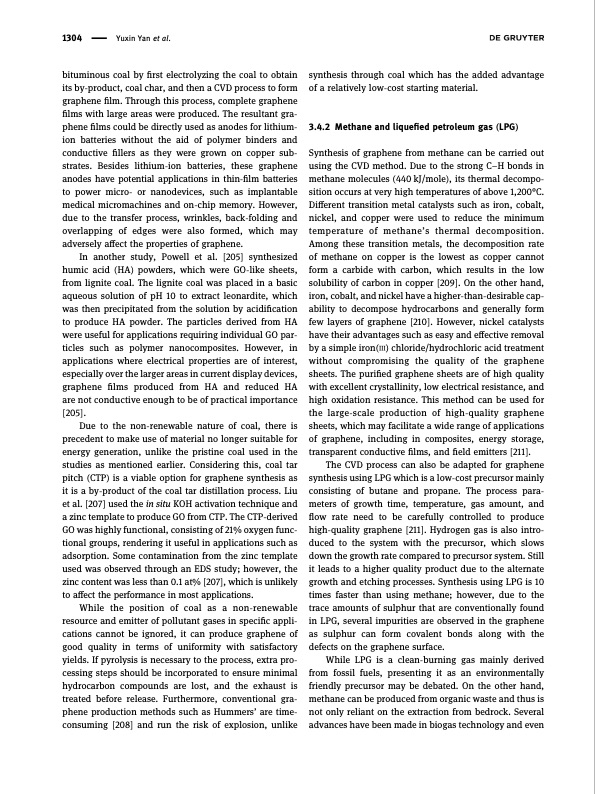PDF Publication Title:
Text from PDF Page: 021
1304 Yuxin Yan et al. bituminous coal by first electrolyzing the coal to obtain its by-product, coal char, and then a CVD process to form graphene film. Through this process, complete graphene films with large areas were produced. The resultant gra- phene films could be directly used as anodes for lithium- ion batteries without the aid of polymer binders and conductive fillers as they were grown on copper sub- strates. Besides lithium-ion batteries, these graphene anodes have potential applications in thin-film batteries to power micro- or nanodevices, such as implantable medical micromachines and on-chip memory. However, due to the transfer process, wrinkles, back-folding and overlapping of edges were also formed, which may adversely affect the properties of graphene. In another study, Powell et al. [205] synthesized humic acid (HA) powders, which were GO-like sheets, from lignite coal. The lignite coal was placed in a basic aqueous solution of pH 10 to extract leonardite, which was then precipitated from the solution by acidification to produce HA powder. The particles derived from HA were useful for applications requiring individual GO par- ticles such as polymer nanocomposites. However, in applications where electrical properties are of interest, especially over the larger areas in current display devices, graphene films produced from HA and reduced HA are not conductive enough to be of practical importance [205]. Due to the non-renewable nature of coal, there is precedent to make use of material no longer suitable for energy generation, unlike the pristine coal used in the studies as mentioned earlier. Considering this, coal tar pitch (CTP) is a viable option for graphene synthesis as it is a by-product of the coal tar distillation process. Liu et al. [207] used the in situ KOH activation technique and a zinc template to produce GO from CTP. The CTP-derived GO was highly functional, consisting of 21% oxygen func- tional groups, rendering it useful in applications such as adsorption. Some contamination from the zinc template used was observed through an EDS study; however, the zinc content was less than 0.1 at% [207], which is unlikely to affect the performance in most applications. While the position of coal as a non-renewable resource and emitter of pollutant gases in specific appli- cations cannot be ignored, it can produce graphene of good quality in terms of uniformity with satisfactory yields. If pyrolysis is necessary to the process, extra pro- cessing steps should be incorporated to ensure minimal hydrocarbon compounds are lost, and the exhaust is treated before release. Furthermore, conventional gra- phene production methods such as Hummers’ are time- consuming [208] and run the risk of explosion, unlike synthesis through coal which has the added advantage of a relatively low-cost starting material. 3.4.2 Methane and liquefied petroleum gas (LPG) Synthesis of graphene from methane can be carried out using the CVD method. Due to the strong C–H bonds in methane molecules (440 kJ/mole), its thermal decompo- sition occurs at very high temperatures of above 1,200°C. Different transition metal catalysts such as iron, cobalt, nickel, and copper were used to reduce the minimum temperature of methane’s thermal decomposition. Among these transition metals, the decomposition rate of methane on copper is the lowest as copper cannot form a carbide with carbon, which results in the low solubility of carbon in copper [209]. On the other hand, iron, cobalt, and nickel have a higher-than-desirable cap- ability to decompose hydrocarbons and generally form few layers of graphene [210]. However, nickel catalysts have their advantages such as easy and effective removal by a simple iron(III) chloride/hydrochloric acid treatment without compromising the quality of the graphene sheets. The purified graphene sheets are of high quality with excellent crystallinity, low electrical resistance, and high oxidation resistance. This method can be used for the large-scale production of high-quality graphene sheets, which may facilitate a wide range of applications of graphene, including in composites, energy storage, transparent conductive films, and field emitters [211]. The CVD process can also be adapted for graphene synthesis using LPG which is a low-cost precursor mainly consisting of butane and propane. The process para- meters of growth time, temperature, gas amount, and flow rate need to be carefully controlled to produce high-quality graphene [211]. Hydrogen gas is also intro- duced to the system with the precursor, which slows down the growth rate compared to precursor system. Still it leads to a higher quality product due to the alternate growth and etching processes. Synthesis using LPG is 10 times faster than using methane; however, due to the trace amounts of sulphur that are conventionally found in LPG, several impurities are observed in the graphene as sulphur can form covalent bonds along with the defects on the graphene surface. While LPG is a clean-burning gas mainly derived from fossil fuels, presenting it as an environmentally friendly precursor may be debated. On the other hand, methane can be produced from organic waste and thus is not only reliant on the extraction from bedrock. Several advances have been made in biogas technology and evenPDF Image | Synthesis of graphene Potential carbon precursors

PDF Search Title:
Synthesis of graphene Potential carbon precursorsOriginal File Name Searched:
10-1515-ntrev-2020-0100.pdfDIY PDF Search: Google It | Yahoo | Bing
Salgenx Redox Flow Battery Technology: Power up your energy storage game with Salgenx Salt Water Battery. With its advanced technology, the flow battery provides reliable, scalable, and sustainable energy storage for utility-scale projects. Upgrade to a Salgenx flow battery today and take control of your energy future.
CONTACT TEL: 608-238-6001 Email: greg@infinityturbine.com (Standard Web Page)